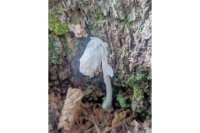EPA announces completion of Helene response in WNC
The U.S. Environmental Protection Agency (EPA) announced that the agency has completed its work supporting the Federal Emergency Management Agency (FEMA), the North Carolina Department of Environmental Quality (NC DEQ), the U.S. Army Corps of Engineers and local health departments with hurricane response efforts in western North Carolina.
Haywood Waterways assists EPA to perform Hazard Assessment Surveys
The day after Helene moved through the region, Haywood Waterways Association (HWA) was on the phone calling partners or visiting sites as they could to assess how they fared and if HWA could do anything to assist.
EPA visits WNC
On Oct. 10, U.S. Environmental Protection Agency Administrator Michael S. Regan joined North Gov. Roy Cooper, Sen. Thom Tillis, Rep. Chuck Edwards, Asheville Mayor Esther E. Manheimer and local officials to assess federal and state recovery efforts in response to Hurricane Helene.
How the sale of Canton’s mill site may impact EPA efforts
In the hours following the announcement that Pactiv Evergreen’s paper mill property in Canton may have a new owner in the coming months, news came and fast and furious.
Bringing in the feds: EPA agreement mandates elements of Canton mill cleanup
Pactiv Evergreen, owner of the shuttered papermill in Canton, has been working to clean up two separate seeps leaking toxic substances into the Pigeon River under an administrative order of consent (AOC) with the Environmental Protection Agency.
March kicks off 2024 ozone season
March 1 marked the beginning of the 2024 ozone season as state and local environmental agencies renew their daily air quality forecasts for ozone across North Carolina.
Coming down the pipe: EPA mandate could soak local utility customers
A recent update to the U.S. Environmental Protection Agency’s Lead and Copper Rule directs nearly all of the nation’s water systems to conduct an inventory of service lines by October, checking for the presence of lead pipes due to their well-established health risks.
The rollback administration
The present administration is no friend to the environment.
In a New York Times analysis, which was based on data from Harvard Law School, Columbia Law School and other sources, the Times reported more than 90 environmental rules and/or regulations had been or were in the process of being rolled back. According to the report, 58 rollbacks had already occurred and 37 were in process.
The Naturalist's Corner: Speak up
If you want the opportunity to have knowledge about and input on actions, policies and/or decisions affecting property you own, you need to speak up now. The present administration and the USDA Forest Service announced, in June, plans to “streamline” the National Environmental Policy Act (NEPA) protocols when it comes to actions receiving federal funding on federal lands, which the public owns.
Vehicle emissions testing goes up in smoke
A multi-year effort by Burnsville Republican Rep. Michele Presnell to scrap vehicle emissions testing requirements in more than two dozen North Carolina counties finally got the green light from the U.S. Environmental Protection Agency.









